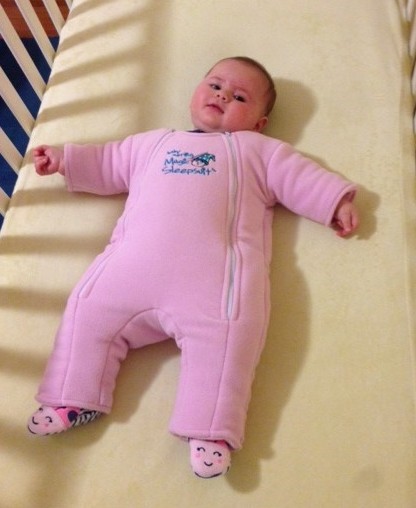Restrictive Sleep Suits
– From the Perspective of a Pediatric Physical Therapist –
There are many opinions out there about the “dos” and “don’ts” of sleep training and sleep options for infants. A common trend nowadays is to consider a restrictive sleep suit, such as the popular marketed ones that are slightly weighted, to help baby transition out of the swaddle and bassinet. From a pediatric physical therapist perspective, let’s discuss the pros and cons of those sleep options.
What are these things?
These sleep suits are marketed for families that are about to transition out of swaddling their newborns. They boast the ability of these products to decrease a baby’s twitches and startles that wake them in the night when placed on their backs. They are intended for use in a temperature-controlled environment and for back sleeping only. So let’s break it down, looking at all angles of these “sleep suit” devices.
The Positives:
- – Soft Material
- – No Need for Blankets
- – Many Different Sizes
- – Symmetrical Sensory Input Across The Entire Body (This is especially good for children who may be calmed by the deep pressure provided by the swaddle or enjoys big cuddles by their parent.)
- – Positive Reviews Online

The Not-So-Positives:
- Arrests Baby’s Movement – “Stops Twitches”
- – While many of these sleep suit manufacturers argue that this is a positive of the product, it could actually be considered more of a negative. Even though they are sleeping, children need to move in their sleep.
- – In fact, there are researchers across the country studying the twitches that occur while baby is asleep. Researchers at the University of Iowa mention, “when the sleeping body twitches, it’s activating circuits throughout the developing brain and teaching newborns about their limbs and what they can do with them.”
- – If there is a chance that a baby is learning about their body through these twitches and movements they perform in their sleep, perhaps we should allow them, not dampen them.
- Head Shape Concerns
- – Plagiocephaly is a condition when a child has flatness on one side of their head more than the other. Brachycephaly is when a child has a flat spot that is centered on the back of their head.
- – While the sleep suits have yet to be linked conclusively to plagiocephaly, they may be associated with a different kind of flat head syndrome called brachycephaly, due to the suit limiting larger movements during the child’s sleep resulting in fewer position changes.
- – A child with torticollis, or asymmetry in the cervical musculature, would definitely not benefit from a sleep suit, as it would easily play into the one sided positioning of their head during sleep.
- Holds child in a “starfish” position
- – Many of these suits keep the child in what could be described as a starfish position (arms out wide, legs straight).
- – This is a position similar to the first phase of what is known as the Moro Reflex (the startle reflex). This reflex should be integrated by about 4-6 months, meaning, it is used functionally to help protect a child. The starfish position of these sleep suits may contribute to continued retention of this reflex if their nervous system is not quite ready to integrate it.
- – The second phase of the reflex involves the child returning to a fetal position. Unfortunately, if a child startles while in one of these sleep suits, they will be unable to complete the calming second phase of the reflex.
- Poor hip health and positioning
- – The sleep suits generally promote the child to have their hips extended and completely straight. It is not recommended that the legs be fully extended in this position until they are about 6 months old to promote proper development of the hip and its seating into the hip socket.
- – The caveat to that is, some may allow the hip to be in a healthier froggy position (hip abduction and external rotation).
What is the verdict?
The intent of this information is to discuss both the known positives as well as considerations for non-use. For families that choose to use these products, please refer to a few tips to consider with its usage:

- If you’re going to use it, use it for sleep ONLY.
- STOP using the suit if your child is able to roll in it, or is fighting it in any way.
- Keep an eye on your child’s head shape, look for flatness on one side or in the center of the back of their head
- Reach out to a pediatric physical therapist if you’re noticing flatness or that your child is beginning to prefer looking to only one side during sleep and/or when they are wake
- When they are awake practice these activities often:
- Tummy Time, Tummy Time, Tummy Time. It is important to offload the back of their head and get them out of that starfish position.
- Encourage your child to bring their hands together to a toy if they’re not already doing so. This will also encourage independent movement out of the starfish position while improving their ability to integrate the startle reflex.
- Also, encourage plenty of hands and feet play and other full flexion postures to counter balance the starfish position that the sleep suit encourages for prolonged periods of time.
- Be sure to practice rolling from back to tummy. If your child is very comfortable on their back, you’ll want them to learn how to independently roll onto tummy to develop the many skills acquired from sufficient tummy time.

Give it a Try at Home!
Try these developmental activities with your little one today! If you’re at all worried about your child’s developmental progress, hip health, flat spot, or side preference, call the pediatric physical therapy specialists at Chicago Pediatric Therapy & Wellness Center at 773-687-9241 to discuss your concerns. Our experienced clinicians will be sure to give you an activity program and sleeping suggestions that are tailored to your little one’s specific development.

